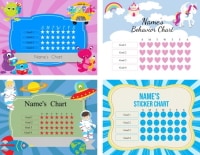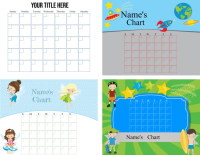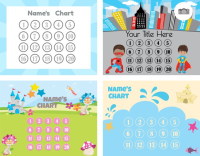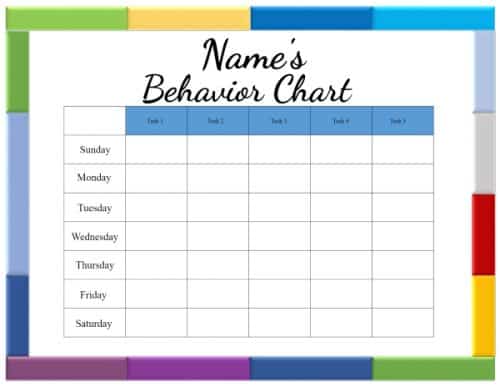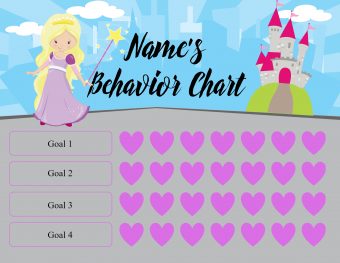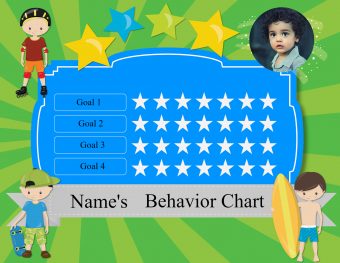Behavior Charts
Are you looking for an easy way to improve your kids’ behavior? Are you fed up with their bad behavior? You’ve come to the right place! These free printable behavior charts can improve your child’s behavior overnight. All of our charts are free! No registration is required to download or print.
Select a Chart by Age
Each behavior chart template is available in three formats: daily, weekly or monthly.
The seven-day-week weekly behavior chart is a good behavior chart for home whereas the five-day week is more appropriate for school or school-related behavior such as homework.
Free Behavior Chart Maker
Create a DIY behavior chart for kids that you can customize online before you print.
- Change the background and the theme.
- Add clipart with various themes such as princesses, superheroes, space, and many more.
- Edit the text and add additional text.
- Add your child’s photo.
- Select a daily, weekly, or monthly layout or a number of steps.
- Designs for all ages. See pre-k and preschool behavior chart, and charts for older kids.
- There are some behavior chart examples below but there are hundreds of options available and they are all free!
Free Printable Behavior Charts
Behavior Chart Template
This behavior chart has sections for tracking daily goals and activities. It includes a goal for earning a certain number of stickers, with a reward if they reach that target. Available with Sunday or Monday start options, it helps teach responsibility and goal-setting.
This behavior chart helps kids track their daily activities with sections for setting and monitoring goals. It doesn’t include a reward system, focusing instead on building responsibility and good habits. Available with Sunday or Monday start options.
You can use this generic behavior chart for many different purposes.
With our free behavior chart maker you can add any background, photos or clipart with a click of your mouse, edit the text and add more text.
Tired of yelling at your kids? Fed up with the nagging & arguing? Want a happier and calmer atmosphere at home? You’ve come to the right place! Behavior charts are an amazing tool which can transform your child’s behavior almost immediately. Moreover, all of our charts are free!
FAQ
For what ages can these charts be used to improve behavior?
Behavior charts are most effective for children aged 3 to about 7 or 8. The number of stars or steps on the chart should be adjusted according to the child’s age. For younger children up to age 5, a chart with 10 steps is recommended. For children aged 5 to 8, a chart with up to 20 steps is more suitable.
Do you have charts for younger kids?
We offer free preschool behavior charts and even have free toddler reward charts.
What are behavior charts?
Behavior charts track a child’s behavior and reward positive desirable behavior. The reward can either be the sticker on the behavior chart or a treat that children receive when they earn enough stars. Decide on the required number of stars ahead of time and let the child know. The amount depends on the child’s age. Charts with only ten steps usually work best for kids age 3 to 5, while older kids typically need around 20 steps. We offer a variety of free behavior charts that you can download and print.
Why do behavior charts work?
Positive reinforcement is the best way to encourage and maintain good behavior. Children love to be praised and encouraged. A good behavior sticker chart ensures that we praise desirable behavior, which we otherwise might not have recognized.
Children love to be praised and sometimes need to be encouraged and motivated. However, we often criticise bad behavior and forget to focus on and reward positive behavior. Studies have proven that it is far more effective to reward positive behavior than to focus on negative behavior. Often, we forget to praise our kids for their small achievements while undesirable behavior is never forgotten. Sticker charts help us recognize, encourage and reward positive behavior.
How do you use these charts?
- Show your children our selection of printable charts and let them choose one.
- Download and print the chart of their choice.
- Define “good behavior” and discuss it with your children. Make sure they understand how you would like them to behave and what kind of behavior you will reward with a star or sticker. For example, if your children come into your bed during the night, then explain to them that each night that they stay in their bed throughout the night, they will get a star.
- When the chart is complete, acknowledge their achievement with a reward.
- Make the process fun and enjoyable!
How do you customize the editable behavior charts?
If you have selected an editable behavior chart, then you can edit the text and add your own image.
- Click on the editable behavior chart to open the chart maker.
- You can make any color chart for kids since every element can be edited. You can make a weekly schedule, chore chart, sticker chart, etc.
- Edit the text and add more text if you have anything else to add.
- Add a photo.
- Download your printable chart to your PC and print.
If the child has specific needs, then use the search bar to search for specific solutions such as an ODD behavior chart for kids with oppositional defiant disorder.
How to develop and use a reward program
According to CDC, there are six steps:
Step 1: Decide what specific behaviors you want to reward
Pick a few specific actions that your child will clearly understand. For example, don’t write “behave well,” but rather “no hitting.” Only choose responses that your children are capable of and are suitable for their age.
Step 2: Decide on the reward
The reward should be something your child wants to earn and will enjoy. It doesn’t have to cost money. Getting the stickers on the chart can be the reward. If that will not work for your children, then decide on a reward when they earn a certain number of stickers such as going out for ice cream.
Step 3: Create a behavior chart
Select a behavior chart from this site. You can add pictures to any chart. Click on “add photo” and add a photo if your child cannot read yet. For example, instead of writing “tidy your room” add a photo of your child’s room when it is tidy.
Step 4: Explain the reward program to your child
Your children need to understand what they have to do to get a sticker on their behavior chart.
Step 5: Use the reward program
Remember to give them a sticker on their chart immediately after the behavior. This will ensure that they know exactly what they did to earn the reward.
Step 6: Slowly change the selected behavior or phase out the reward program
Reward your children often when you use the behavior chart. Over time, you will notice a change in their behavior. Once this new behavior has become a habit, you can either stop using the sticker chart template or start a new chart with new goals.
Should you take off stickers for bad behavior?
No. Never take away rewards your children have earned. Rewards that they have earned are theirs, and you should not take them away for misbehaving.

